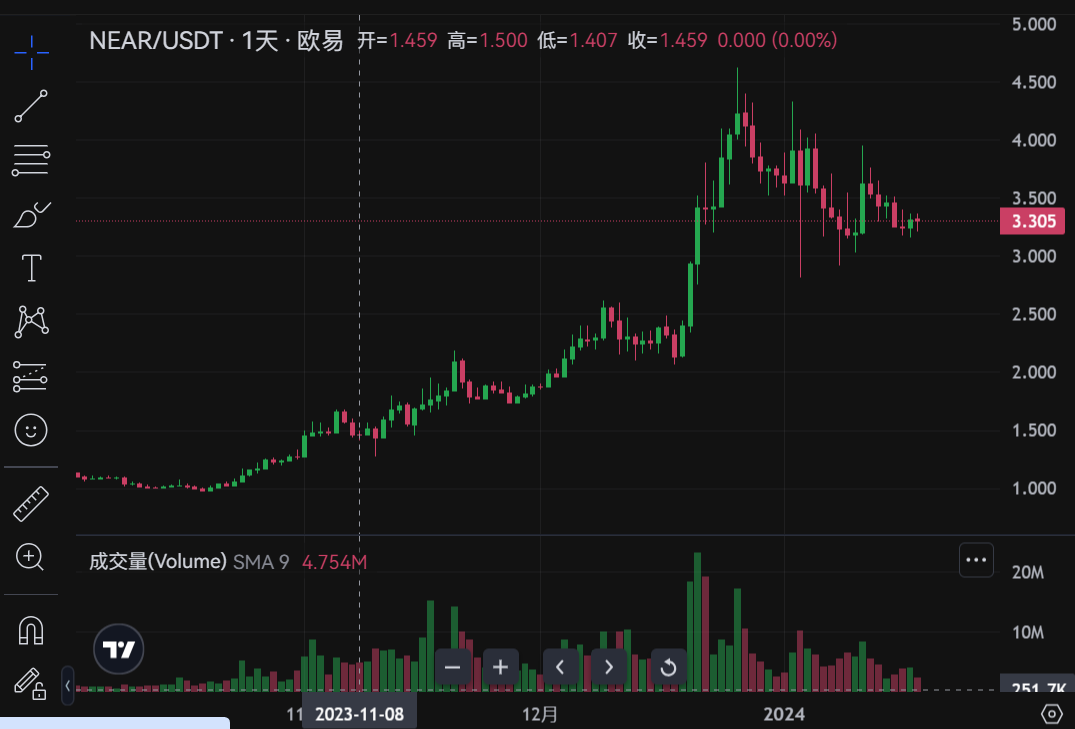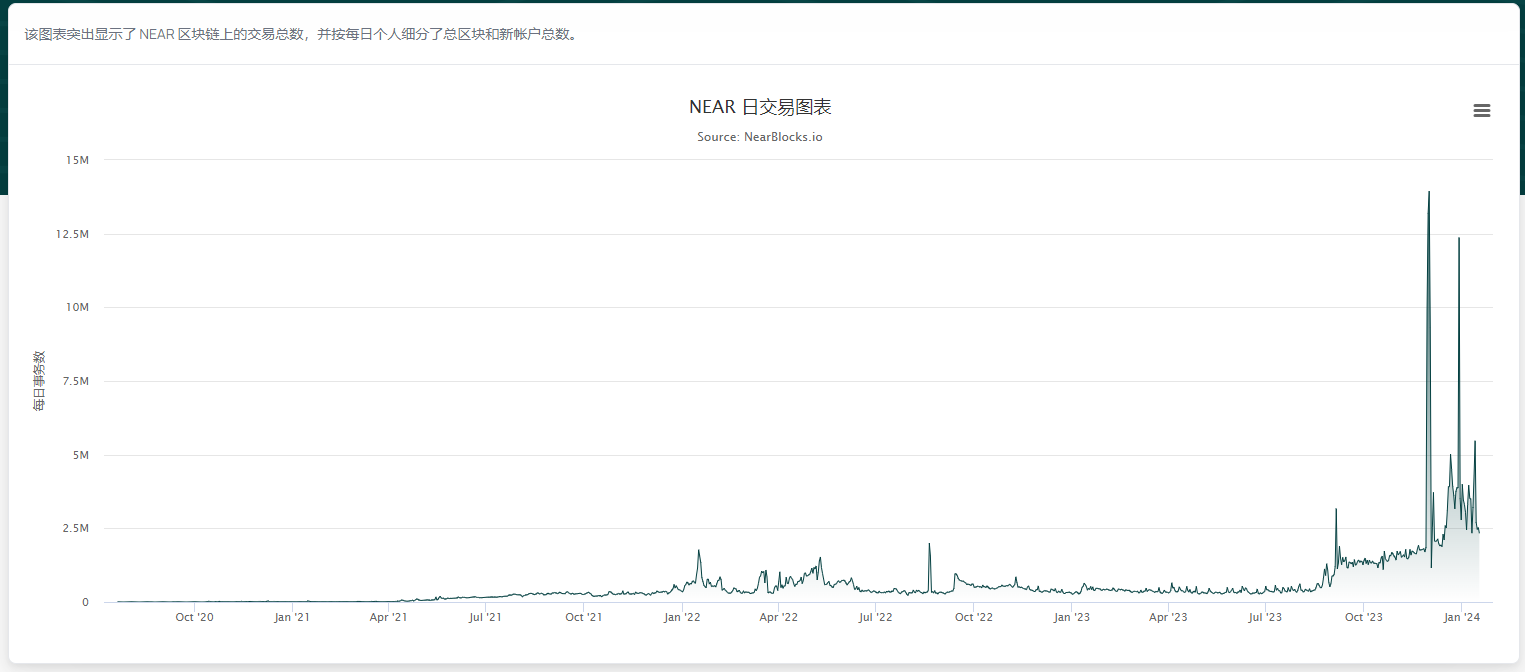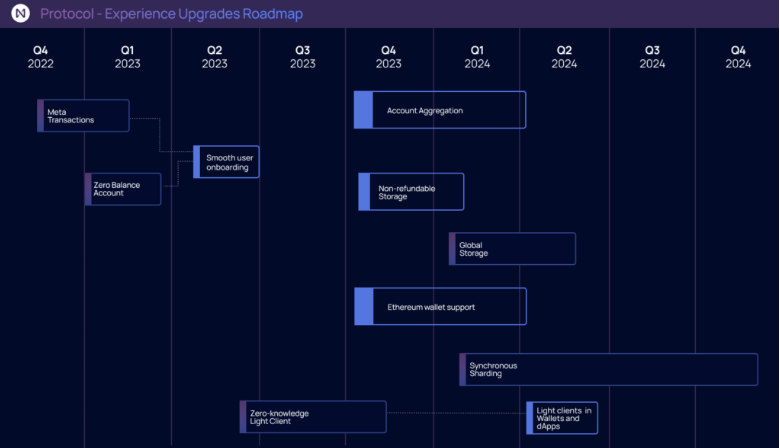In 2 months, 3 executives changed, and at the beginning of the year, layoffs of 40%. Is this Near's "infighting" or "self-rescue"?
Author: Grapefruit, ChainCatcher
Editor: Marco, ChainCatcher
In just two days, Near officially announced two controversial actions: first, the foundation announced a 40% staff reduction, and then released the 2024 update roadmap.
On January 11, the Near Foundation announced it would reduce its team by 40%, primarily affecting the marketing, business development, and community teams, involving 35 employees. This layoff will reduce the Near Foundation's team from an initial 90 members to about 55.
The next day, Near released its 2024 update roadmap, introducing state-less validation, developing zkWASM, and improving data availability, among other initiatives, to enhance the usability, scalability, and decentralization of the NEAR protocol.
The current cryptocurrency market is at a critical juncture from bear to bull, with most Web3 projects hiring and expanding their teams in anticipation of the next bull market, while the Near Foundation is taking a completely opposite approach with widespread layoffs and a smaller team.
Why did Near announce significant layoffs at such a critical moment in the cryptocurrency market cycle? Is this a long-rumored "internal conflict" or a "self-rescue action"?
Foundation Layoffs of 40%
Currently, users and the market view the Near Foundation's layoffs as more beneficial than detrimental. Most community users believe this layoff is the result of Near founder Illia Polosukhin (referred to as Illia, translated as "Yilong" in Chinese) returning to the foundation to reorganize the team, streamlining expenses, saving costs, and eliminating unnecessary personnel, which is a significant positive for Near's future development.
This conclusion is drawn from two key pieces of information released in the layoff announcement: first, it aims to improve the foundation's work efficiency as a result of a thorough review of its activities; second, it disclosed the foundation's financial situation, which currently holds assets valued at over $1.3 billion.
Illia stated in the layoff announcement that the Near Foundation, along with its council (NFC), conducted a thorough review of the foundation's activities. During this process, feedback indicated that the foundation was not always effective, sometimes acting too slowly and trying to do too many things at once. Following this review, the team decided to significantly consolidate the core foundation team, narrowing its focus to more impactful activities.
He noted that as part of this reorganization, the NEAR Foundation would reduce its team by about 40%, affecting 35 colleagues, primarily in marketing, business development, and community teams.
The layoff announcement stated that the Near Foundation's financial situation remains stable and strong, with over $285 million in fiat currency, 30.5 million NEAR tokens (valued at over $1 billion), and $70 million in investments and loans.
After the layoff announcement, some community users expressed optimism about Near's decision, believing it streamlined personnel, improved efficiency, and reduced expenses while addressing long-standing complaints about the foundation's low operational efficiency and lack of focus on ecosystem development. The solid financial data also indirectly clarified the long-rumored "Near Foundation is out of money" rumors.
In response, a community user commented that Near has finally begun to pay attention to the foundation's issues. As an important organization driving the development of blockchain project ecosystems, the foundation not only manages substantial funds that determine the project's future but also needs to formulate development and marketing strategies that align with its own characteristics and support high-quality early-stage ecosystem projects. Now, the Near Foundation publicly states it manages over $1.3 billion in crypto assets, most of which will be used to support ecosystem development or strongly back ecological projects, which is a significant positive for Near's future ecosystem growth.
On the day of the layoff announcement, the NEAR token price surged from $3.19 to $3.69, with an intraday increase of over 15%. By January 22, the NEAR price had retreated to around $2.9.
Three Changes in Leadership in Two Months
Users are also concerned about an important reason behind the surface of the Near Foundation's layoffs: whether this layoff is related to founder Yilong's return to the foundation.
Since September 2023, the Near Foundation's senior management has undergone three major changes.
In September last year, Marieke Flament, who had served as CEO of the Near Foundation since the first quarter of 2022, announced her resignation.
Subsequently, the foundation was led by legal advisor Chris Donovan.
On November 7, Near founder Yilong announced his return to the foundation as CEO, responsible for leading the Near ecosystem into the next phase of building an open network, while Chris Donovan was reassigned as Chief Operating Officer.
After the Near Foundation appointed former Circle and Mettle executive Marieke Flament as CEO in January 2022, Yilong stepped away from the foundation.
In less than two months, the Near Foundation experienced three changes in its CEO position. Users have speculated about the reasons for the frequent personnel changes, with rumors of internal conflict circulating.
The real unveiling of the Near Foundation's issues came with the "Wintermute's USN Redemption Controversy."
On November 8, 2023, Wintermute founder Evgeny Gaevoy publicly criticized the Near Foundation and Aurora Labs (the developer of Near's EVM chain, with founding members also from the Near team) on social media, accusing them of being untrustworthy and failing to honor a commitment to redeem $11.2 million worth of the stablecoin USN.
According to the Wintermute founder's statements, the controversy can be simply understood as follows: before purchasing FTX assets, Aurora indicated to Wintermute that it could redeem any amount of USN for USDT without needing to provide the source of funds. Under this assurance, Wintermute purchased $11.2 million worth of USN stablecoins from FTX assets, but when Wintermute attempted to redeem USN for USDT, Near and Aurora refused.
In response to this matter, Illia and the foundation explained that after USN was closed due to insufficient collateral, the USN Protection Plan (USNPP) was established, operated by Aurora Labs, to protect affected individuals. Wintermute's request was denied because it was suspected of exploiting the USN purchased from FTX for arbitrage, which could cause losses to ecosystem users.
However, this incident once again pointed to the relationship between the Near Foundation and the aborted stablecoin project USN, raising continuous doubts about their connection.
Some users commented, "The Near Foundation is worse than hackers; they promised USN could be exchanged for USDT, but now they don't support it, swallowing tens of millions of dollars." Others remarked, "The stablecoin USN is not officially launched by Near, but the Near Foundation's operations seem to indicate a close relationship with USN, as if it were an officially incubated project, which is really chaotic management." The rumor that "the Near Foundation is out of money" also originated from here.
Public information shows that the stablecoin USN was issued by Decentral Bank on Near in 2022. Although Decentral Bank claims to be an independently operated community project without direct financial assistance from the Near Foundation, the stablecoin was primarily generated through NEAR token collateral and received public support from the Near Foundation at its launch, leading users to mistakenly believe that USN is operated by the Near Foundation.
In October 2022, after USN was announced to be closed due to insufficient collateral, the Near Foundation immediately established a $40 million fund to support the conversion of USN to USDT. This support for conversion further fueled user suspicions about an unspoken relationship between USN and the Near Foundation.
As of January 22, there has been no clear conclusion regarding the dispute between Wintermute and the Near Foundation, and the Wintermute founder has not ceased his accusations, stating that if the Near Foundation continues in this manner, he will pursue legal action.
The controversy with Wintermute has unveiled issues such as the Near Foundation's chaotic team management and unclear boundaries with ecosystem stakeholders.
Yilong's return at this critical juncture is also seen as an attempt to rectify the Near Foundation's chaotic team management issues. Just two months after returning to the foundation, he announced a 40% layoff, indicating a cleansing of the team.
Near's Development Dilemma: Stagnant TVL Growth and Sparse On-Chain Applications
Since Yilong announced his return to the foundation, Near has also announced a series of new initiatives in product development.
First, the Near Foundation announced a collaboration with Polygon Labs to develop a zero-knowledge proof ZK virtual machine, zkWASM; next, it launched a new project, Near DA, a data availability layer, entering the modular blockchain space; then, it partnered with Eigen Labs to build a fast finality layer for Ethereum Layer 2, reducing transaction times and costs to one-fourth of the original.
With the overall recovery of the cryptocurrency market, the NEAR token price has also risen sharply, from $1.5 on November 8 to a peak of $4.6 on December 6, with a cumulative increase of over 200%. By January 22, it had retreated to $2.9.

However, from the on-chain operational data, this series of actions has not brought any turnaround to the development of the Near ecosystem, with the number of on-chain applications stagnating and no new growth in TVL.
According to data from the DeFiLlama platform, since April 2023, the TVL on the Near chain has hovered around $30 million, only improving slightly by the end of December. As of January 22, the value of crypto assets locked on the Near chain was $88.27 million, ranking 31st among various public chains, with only 22 on-chain applications.

Regarding the series of actions taken by Yilong after returning to the foundation, community user Moli (pseudonym) views them as a self-rescue effort for Near. Currently, Near's development is in a dilemma, with its on-chain ecosystem long stagnating, lacking new applications and low user activity, requiring new vitality to be injected.
He explained that compared to contemporaries like Solana, Polygon, and Avalanche, Near has always lagged behind in development, and the gap is widening. During the last EVM network hype, Near launched its EVM network Aurora the latest, only at the end of the bull market, while now Solana has completely emerged from the shadow of the FTX collapse due to its ecosystem wealth effect; Polygon has successfully transformed into a leading Layer 2 project by seizing the Layer 2 narrative and attracting a batch of developers; although Avalanche's popularity has not fully recovered, the hype around on-chain meme coins has not ceased.
In contrast, the Near network has consistently shown instability and lack of fire, with almost no new on-chain applications, only a few established DEXs, lending, and liquid staking protocols available for participation.
During the hype of public chain inscriptions in November last year, Near also took the opportunity to launch the inscription project NEAT, which received support from Yilong and several Near ecosystem KOLs, attracting a large number of users to participate, even leading Binance and OKX to temporarily halt withdrawals. On November 30, its on-chain transaction volume exceeded ten million, setting a single-day transaction record, with over 170,000 new wallet addresses created on-chain.

Although the emergence of the NEAT inscription brought a massive amount of heat and attention to the Near ecosystem in a short time, the ecosystem applications could not sustain it. Users seemed to find no more engaging applications beyond speculating on the price of inscriptions.
As the heat of inscriptions cooled, the NEAT token price began to decline sharply, dropping over 50% in the past 14 days to a current price of $0.1. Meanwhile, Near's on-chain transaction data also began to decline.
On January 17, ChainCatcher reported that the Near ecosystem's re-staking platform Linear announced it would airdrop governance tokens LNR to community users. This once again attracted a wave of traffic to Near, making interaction with Near ecosystem applications a new topic in the crypto community, but upon entering the ecosystem, users found very few playable applications on the Near chain.
In response, community user Kai (pseudonym) stated that although Near has innovated in sharding technology architecture, the public chain competition has now entered a white-hot stage, no longer merely a competition of early-stage technologies, but a competition of on-chain application ecosystems and project operation capabilities, including users, developers, and communities.
He suggested that Near's most important focus now should be on developing its ecosystem, especially DeFi applications, and not wait until every wave of traffic arrives without any applications to support it. Moreover, ecosystem prosperity cannot be achieved in a single burst; the official team needs to continuously provide resource support and empowerment for developers and the community.
Focusing on Web2 Chain Transformation, Is Near Attempting "Self-Rescue"?
Regarding the stagnation of on-chain TVL data, long-term NEAR holder Nick stated that the level of TVL data does not accurately reflect Near's on-chain activity, which is mainly related to Near's ecological development strategy. Currently, Near encourages collaboration with Web2 applications that have a user base, helping them rebuild their business models using blockchain technology.
The strategy of "actively supporting Web2 applications' chain transformation" can be confirmed from Yilong's responses in a January interview with DeFiant.
When discussing the development of Near's ecosystem applications, Yilong stated that Near currently hopes to assist Web2 applications with existing user groups in finding their business monetization models through blockchain, rather than focusing on whether projects can bring TVL.
He cited the example of Sweatcoin, an active project on the Near chain, which was originally a Web2 fitness project that successfully transformed into a Web3 walking-for-crypto project through collaboration with Near. Users can earn SWEAT tokens through exercise, which can be traded for profit or used to purchase products from partner brands, such as yoga classes and daily necessities.
The KaiKai application, which caused a surge in Near's on-chain transaction data in September 2023, is also not a native crypto project on the Near network but a "chain-transformed" shopping platform under Cosmose AI, a consumer shopping data analysis platform that Near invested in. It launched a stablecoin pegged to the US dollar, KAI-Ching, allowing users to earn additional KAI-Ching tokens by shopping, having fun, or writing product reviews using the KaiKai App.
According to ecological data statistics from Near Daily, KaiKai and Sweatcoin have become the projects with the most active users in the Near ecosystem over the past 30 days, with KaiKai's active user count exceeding 2 million and Sweatcoin's user count exceeding 1 million.
Although these applications have not directly contributed to TVL growth for Near, their presence has brought their existing users into the Near ecosystem, allowing more external users to utilize Web3 technology, with on-chain interactions and wallet numbers also increasing.
Perhaps by becoming a chain transformation tool for Web2 applications, Near has tasted the traffic dividends brought by such collaborations. Currently, Near's development strategy is also focused on providing developers and users with a high-performance, user-friendly underlying network, aiming to achieve the vision of mainstream adoption of the Near network.
This can also be seen from the 2023 work results and Q4 update roadmap released by Near.
In 2023, the Near network introduced two functional improvements that significantly lowered the barriers to using and entering the Near ecosystem. Among them, the new meta-transaction feature supports gasless transactions, meaning users do not need to use NEAR tokens to pay gas fees when using applications on the Near chain; additionally, zero-balance accounts have been added, allowing users to create wallet accounts without holding NEAR tokens, addressing the previous complaint that creating a wallet account required holding more than 0.1 NEAR tokens, making it easy for new users to use applications.
In the 2024 roadmap, the stateless validation feature introduced by Near not only enhances network security and prevents fraudulent proof implementation but also improves the throughput and performance of each shard. The zkWASM developed in collaboration with Polygon can serve as the EVM execution environment for L2 networks, and the newly launched data availability layer NEAR DA can help developers more easily build L2 networks.
In terms of user experience, the proposed account aggregation feature will allow users to control accounts on different chains using a single Near account, marking an important step in Near's chain abstraction vision. Additionally, the issue of Ethereum wallets like MetaMask not supporting the Near network will also be resolved.

Currently, the data availability layer product NEAR DA has been integrated with developer stacks such as Polygon CDK and Arbitrum Orbit, allowing developers to build their own L2 or L3 networks.
However, regarding this update roadmap, some community users have commented that it aligns with Near's consistent "imitation" style, modifying the roadmap every quarter. First, it copied Ethereum's sharding, then shifted to AI matters after the hype around FET and other AI technologies this year, and now, after the modular TIA and Layer 2 have gained popularity, it has copied the DA layer. They hope that from now on, Near's imitation strategy will come to an end, allowing it to carve out a different path.









